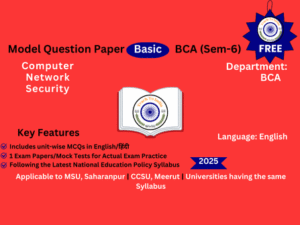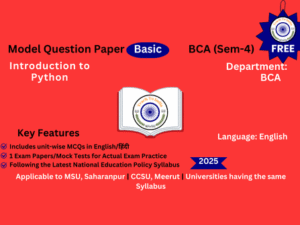Thermal Physics & Semiconductor Devices - ऊष्मा भौतिकी एवं अर्धचालक युक्तियाँ – Adv
- Description
- Curriculum
- Reviews
Model Question Paper
Thermal Physics & Semiconductor Devices – ऊष्मा भौतिकी एवं अर्धचालक युक्तियाँ
Key Features | मुख्य विशेषताएँ
-
Bilingual Model Paper | द्विभाषी मॉडल पेपर
This model paper is Designed in English and Hindi, making it easier for students from both mediums to understand and practice effectively.
यह मॉडल पेपर अंग्रेज़ी और हिंदी दोनों भाषाओं में डिज़ाइन किया गया, जिससे दोनों माध्यमों के छात्रों को अध्ययन और अभ्यास करने में आसानी हो। -
Unit-wise Short Notes | इकाईवार संक्षिप्त नोट्स
Each unit includes a summary in both languages, making revision faster and more effective.
प्रत्येक इकाई में दोनों भाषाओं में सारांश उपलब्ध है, जिससे पुनरावृत्ति तेज़ और प्रभावी हो सके। -
Extensive MCQ Practice | विस्तृत MCQ प्रैक्टिस
1500+ MCQ Practice Questions: This comprehensive question bank includes 1500+ multiple-choice questions (MCQs). Each unit contains approximately 150 MCQs covering a wide range of cognitive levels such as remembering, understanding, application, and analysis.
1500+ MCQ अभ्यास प्रश्न: इस प्रश्न बैंक में 1500 से अधिक बहुविकल्पीय प्रश्न (MCQ) शामिल हैं। प्रत्येक यूनिट में लगभग 150 MCQ हैं, जो याददाश्त, समझ, अनुप्रयोग और विश्लेषण जैसे विभिन्न संज्ञानात्मक स्तरों को कवर करते हैं। -
Exam Practice Paper with Mock Tests | मॉक टेस्ट के साथ परीक्षा अभ्यास पत्र
Includes three full-length mock tests for real exam practice.
तीन पूर्ण मॉक टेस्ट दिए गए हैं, जिससे छात्र वास्तविक परीक्षा अभ्यास कर सकें। -
Latest Syllabus as per NEP | NEP के अनुसार नवीनतम पाठ्यक्रम
The syllabus aligns with the latest National Education Policy (NEP) and follows the exam patterns of MSU, CCSU, and other universities following the NEP.
पाठ्यक्रम नवीनतम राष्ट्रीय शिक्षा नीति (NEP) के अनुसार है और यह MSU, CCSU तथा अन्य NEP का पालन करने वाले विश्वविद्यालयों की परीक्षा प्रणाली का अनुसरण करता है। -
Designed by Experts | विशेषज्ञों द्वारा तैयार किया गया
This question bank has been meticulously prepared by subject matter experts to ensure accuracy and relevance.
यह प्रश्न बैंक विषय विशेषज्ञों द्वारा सावधानीपूर्वक तैयार किया गया है, जिससे इसकी सटीकता और प्रासंगिकता बनी रहे।
Why Choose This Model Paper? | यह मॉडल पेपर क्यों चुनें?
-
Dual-Language Advantage: Ideal for both English and Hindi medium students.
द्विभाषी लाभ: अंग्रेज़ी और हिंदी दोनों माध्यमों के छात्रों के लिए उपयुक्त। -
Complete Exam Preparation: Unit-wise summaries, MCQ practice, and mock tests provide a complete study solution.
पूर्ण परीक्षा तैयारी: इकाईवार सारांश, MCQ अभ्यास, और मॉक टेस्ट संपूर्ण अध्ययन समाधान प्रदान करते हैं। -
Latest NEP-Based Pattern: Ensures compliance with the latest university exam structure.
नवीनतम NEP-आधारित पैटर्न: यह नवीनतम विश्वविद्यालय परीक्षा संरचना के अनुरूप है।Program Class: Certificate/ B.Sc.
Year: First
Semester: Second
Subject: Physics
Course Title: Thermal Physics & Semiconductor Devices
Course Learning Outcomes:
· Recognize the difference between reversible and irreversible processes.
· Understand the physical significance of thermodynamical potentials.
· Comprehend the kinetic model of gases w.r.t. various gas laws.
· Study the implementations and limitations of fundamental radiation laws.
· Utility of AC bridges.
· Recognize the basic components of electronic devices.
·Design simple electronic circuits.
· Understand the applications of various electronic instruments.
Credits: 4
Core Compulsory / Elective
Max. Marks: 25+75
Min. Passing Marks: 33
Unit
Topics
Part A: Thermodynamics & Kinetic Theory of Gases
I
0th & 1st Law of Thermodynamics: State functions and terminology of thermodynamics. Zeroth law and temperature. First law, internal energy, heat and work done. Work done in various thermodynamical processes. Enthalpy, relation between CP and CV. Carnot’s engine, efficiency and Carnot’s theorem. Efficiency of internal combustion engines (Otto and diesel).
II
2nd & 3rd Law of Thermodynamics: Different statements of second law, Clausius inequality, entropy and its physical significance. Entropy changes in various thermodynamical processes. Third law of thermodynamics and unattainability of absolute zero. Thermodynamical potentials, Maxwell’s relations, conditions for feasibility of a process and equilibrium of a system. Clausius- Clapeyron equation, Joule-Thompson effect.
III
Kinetic Theory of Gases: Kinetic model and deduction of gas laws. Derivation of Maxwell’s law of distribution of velocities and its experimental verification. Degrees of freedom, law of equipartition of energy (no derivation) and its application to specific heat of gases (mono, di and poly atomic).
IV
Theory of Radiation: Blackbody radiation, spectral distribution, concept of energy density and pressure of radiation. Derivation of Planck’s law, deduction of Wien’s distribution law, Rayleigh-Jeans law, Stefan-Boltzmann law and Wien’s displacement law from Planck’s law.
PART B: Circuit Fundamentals & Semiconductor Devices
V
DC & AC Circuits: Growth and decay of currents in RL circuit. Charging and discharging of capacitor in RC, LC and RCL circuits. Network Analysis – Superposition, Reciprocity, Thevenin’s and Norton’s theorems. AC Bridges – measurement of inductance (Maxwell’s, Owen’s and Anderson’s bridges) and measurement of capacitance (Schering’s, Wein’s and de Sauty’s bridges).
VI
Semiconductors & Diodes: P and N type semiconductors, qualitative idea of Fermi level. Formation of depletion layer in PN junction diode, field & potential at the depletion layer. Qualitative idea of current flow mechanism in forward & reverse biased diode. Diode fabrication. PN junction diode and its characteristics, static and dynamic resistance. Principle, structure, characteristics and applications of Zener, Light Emitting, and Photo diodes. Half and Full wave rectifiers, calculation of ripple factor, rectification efficiency and voltage regulation. Basic idea about filter circuits and voltage regulated power supply.
VII
Transistors: Bipolar Junction PNP and NPN transistors. Study of CB, CE & CC configurations w.r.t. active, cutoff & saturation regions; characteristics; current, voltage & power gains; transistor currents & relations between them. Idea of base width modulation, base spreading resistance & transition time. DC Load Line analysis and Q-point stabilization. Voltage divider bias circuit for CE amplifier.
VIII
Electronic Instrumentation: Multimeter: Principles of measurement of dc voltage, dc current, ac voltage, ac current and resistance. Specifications of a multimeter and their significance. Cathode Ray Oscilloscope: Block diagram of basic CRO. Construction of CRT, electron gun, electrostatic focusing and acceleration (no mathematical treatment). Front panel controls, special features of dual trace CRO, specifications of a CRO and their significance. Applications of CRO to study the waveform and measurement of voltage, current, frequency & phase difference.
-
1Unit 1: English Summary - Thermal Physics & Semiconductor Devices
-
2Unit 1: Hindi Summary - Thermal Physics & Semiconductor Devices
-
3Unit 1: MCQs -Thermal Physics & Semiconductor Devices- Adv
-
4Unit 2: English Summary - Thermal Physics & Semiconductor Devices
-
5Unit 2: Hindi Summary - Thermal Physics & Semiconductor Devices
-
6Unit 2: MCQs -Thermal Physics & Semiconductor Devices- Adv
-
7Unit 3: English Summary - Thermal Physics & Semiconductor Devices
-
8Unit 3: Hindi Summary - Thermal Physics & Semiconductor Devices
-
9Unit 3: MCQs -Thermal Physics & Semiconductor Devices- Adv
-
10Unit 4: English Summary - Thermal Physics & Semiconductor Devices
-
11Unit 4: Hindi Summary - Thermal Physics & Semiconductor Devices
-
12Unit 4: MCQs -Thermal Physics & Semiconductor Devices- Adv
-
13Unit 5: English Summary - Thermal Physics & Semiconductor Devices
-
14Unit 5: Hindi Summary - Thermal Physics & Semiconductor Devices
-
15Unit 5: MCQs -Thermal Physics & Semiconductor Devices- Adv
-
16Unit 6: English Summary - Thermal Physics & Semiconductor Devices
-
17Unit 6: Hindi Summary - Thermal Physics & Semiconductor Devices
-
18Unit 6: MCQs -Thermal Physics & Semiconductor Devices- Adv
-
19Unit 7: English Summary - Thermal Physics & Semiconductor Devices
-
20Unit 7: Hindi Summary - Thermal Physics & Semiconductor Devices
-
21Unit 7: MCQs -Thermal Physics & Semiconductor Devices- Adv
-
22Unit 8: English Summary - Thermal Physics & Semiconductor Devices
-
23Unit 8: Hindi Summary - Thermal Physics & Semiconductor Devices
-
24Unit 8: MCQs -Thermal Physics & Semiconductor Devices- Adv







